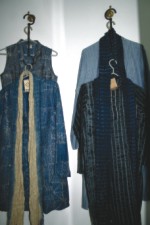Trends
Wrapped in Nature
Hana Shams Ahmed
 |
Photo: Bangladesh National Crafts Council |
They're trendy, they're chic, they're comfortable, they're youthful and most of all they are very, very natural. The fine art of using natural dyes on clothes would have all but disappeared if it weren't for the efforts from a few conscious initiators who have made sure the craft is on a revival and is catching on fast with the fashion-conscious. This Pohela Baishakh, the National Crafts Council of Bangladesh (NCCB), together with 14 craft organisations, is celebrating 25 years of designing with natural dyes in Bangladesh with “Rangeen Utshob”. The organisations are Aranya, Kumudini, Prabartana, Tangail Saree Kutir, Kay Kraft, Banaj Barnali, Proshika, Ayon Crafts, Shishu Polli Plus, Shilleikon, Aakor, Grameen Udyog, Banchte Shekha and Bain Textile in Rangamati.
 |
Photo: Zahedul I Khan |
The use of natural dyes is an ancient art. The first written record of natural dyes use on fabrics dates back to 2600 BC in China. The use of natural dyes in the subcontinent dates back to the Indus Valley civilisation. But with the discovery of chemical dyes in the 19th century, natural dyes slowly began to lose popularity. Bangladesh, which has always been a rich source of natural dyes saw a revival in 1982 through a Research and Development project of the Bangladesh Small and Cottage Industries Corporation (BSCIC).
 |
Naturally dyed fabrics are said to have therapeutic properties. Photo: Zahedul I Khan |
There is potentially an abundance of natural sources of colour available in our environment. Some of the most frequently used are myrabalan, madder, catechu, onion skin, arjun, casuarinas, henna, pomegranate, turmeric, eucalyptus, betel nut, raintree, toon, tea, alkanet, jackwood, mangosteen and flowers like indigo, frangipani, marigold etc. Combinations from these give up to 30 hues of colours that are not only environmentally friendly but many claim that naturally dyed silk have therapeutic properties and provides relief for arthritis, diabetes, headaches and over-excited nerves and is also good for blood circulation.
 |
Photo: Bangladesh National Crafts Council |
A few common misconceptions about natural dyes still exist, as a result of which naturally dyed products are still not in as high a demand as their synthetic counterparts are. One of these is that the colours are dull. But a look at Aranya's Baishakh collection is good enough to shrug off such claims. Only a few colours like emerald green and purple are difficult to generate. The founder and Managing Director of Aranya, Ruby Ghuznavi, a pioneer of sorts in the revival of natural dyes to make them look stylish and comfortable says that in the current context of our environment, natural dyes are the best option for our country. “Natural dyes are non-polluting and eco-friendly and synthetic dyes are 100 percent chemicals,” says Ghuznavi, “and because we only use about one to five percent of chemicals, the pollution level is minimal.”
 |
Photo: Zahedul I Khan |
Another general fallacy about natural dyes is that they are not colourfast. But as Ghuznavi points out anything fabric left out in the scorching Bangladeshi sun for too long will lose its colour. It's very important, especially in case of naturally dyed fabrics, for fabrics to be dried in the shade. And because of the bleach used in most commercially-used detergents, leaving naturally-dyed clothes in them for too long can allay the colour to some extent. “Everything we sell here (at Aranya) is 100% colourfast,” says Ghuznavi, “If the clothes are washed very quickly there's no chance of the colour getting ruined, even the best of chemical dyes tend to fade if left out in the sun for too long.”
 |
The heads of the 14 craft organisations that are displaying their naturally dyed products in the 'Rangeen Utshob'. Photo: Zahedul I Khan |
Another constructive aspect of natural dyes is that it generates a lot of employment. “But as important as that is the fact that all locally produced materials are used,” says Ghuznavi, “we don't have to import anything from abroad, the raw materials are readily available here.” And using raw materials like onionskin is a good way to recycle waste products. “The Worldwide environment concern has created a wider interest in natural dyes,” says Ghuznavi, “and many people are trying to get their product in the mainstream market.” Ghuznavi believes that if larger NGOs like Aarong started using natural dyes commercially, it would give this trade a much-required boost. Synthetic dyes are also only marginally less expensive than natural dyes and because a lot of waste material, like onionskin, it's very cheap.
“Rangeen Utshob” is welcoming Baisakh with the traditional red and white, red and mustard and vivid blues and greens. All organisations will present natural dye products in their respective showrooms. Aranya will stock products of those who do not have retail outlets in Dhaka.
The main objective of the festival is to create greater awareness amongst the public about the beauty and value of Bangladesh's traditional skill of natural dyes. Only with wider public support can the future of natural dyes be assured in Bangladesh.
Copyright
(R) thedailystar.net 2007 |
